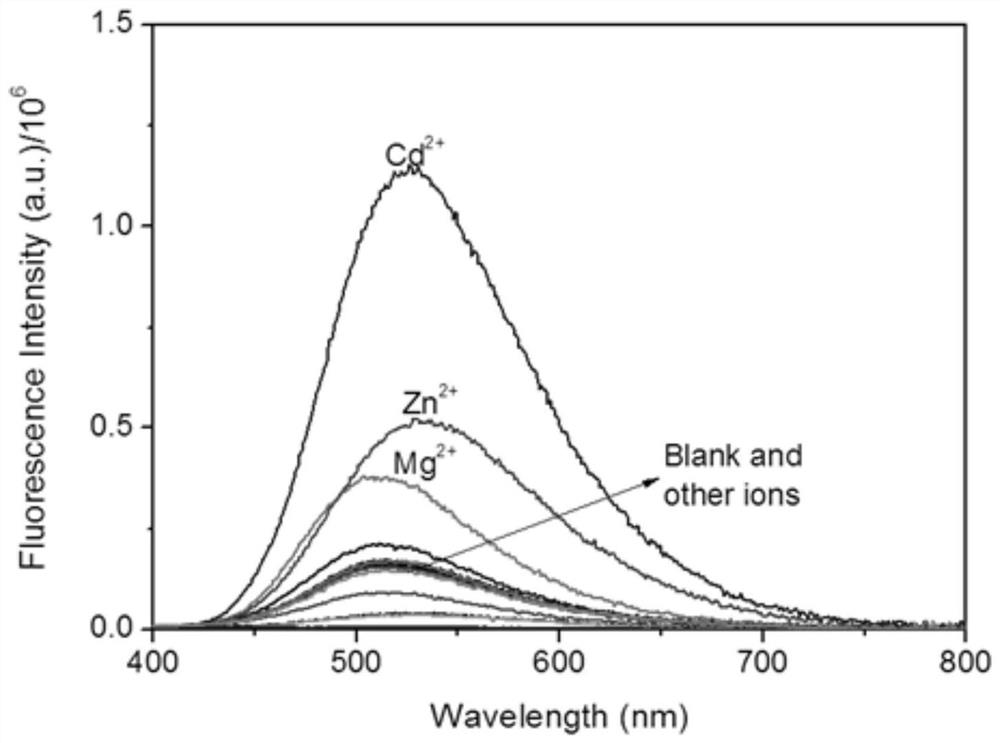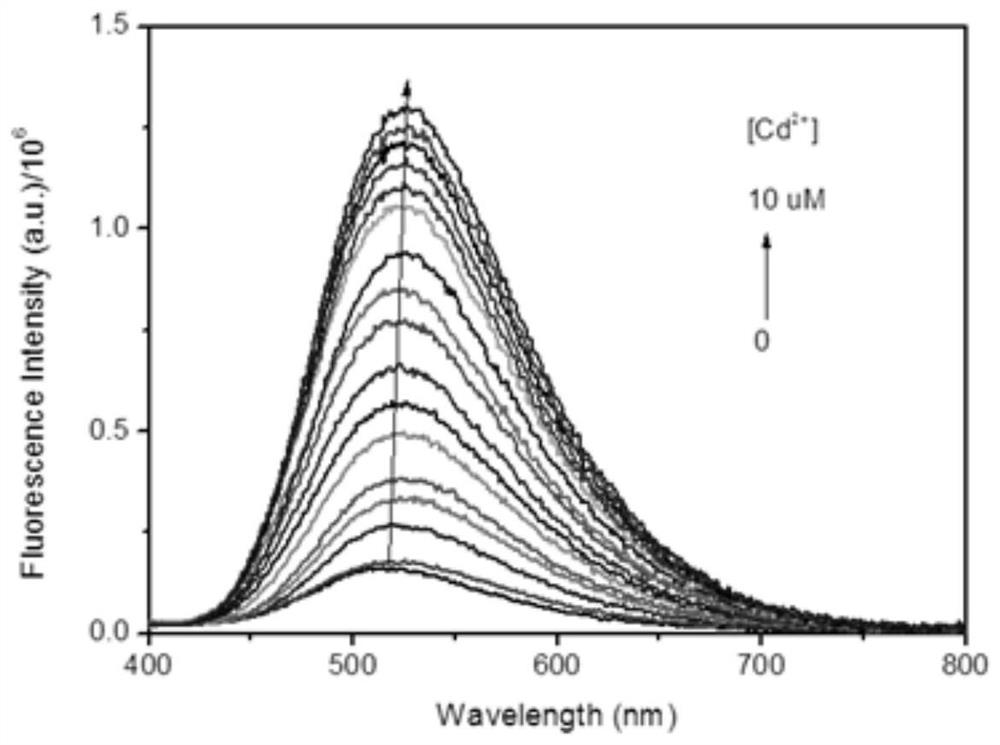A kind of fluorescent probe and its preparation and application
A technology of fluorescent probe and reflux reaction, applied in the field of fluorescent probe and its preparation and application, can solve the problems of simple synthesis, high yield, change, etc., and achieve the effect of cheap raw materials, high yield, and simple preparation method
- Summary
- Abstract
- Description
- Claims
- Application Information
AI Technical Summary
Problems solved by technology
Method used
Image
Examples
Embodiment 1
[0034] Synthesis of fluorescent probes:
[0035] (1) Synthesis of 5,7-dialdehyde-8-hydroxyquinoline: 8-hydroxyquinoline (1.0g) and hexamethylenetetramine (2.0g) were dissolved in trifluoroacetic acid (10.0mL), Reflux at 110°C for 72 hours, remove the solvent by rotary evaporation, wash with dilute hydrochloric acid, filter, wash the solid with water until neutral, and dry in vacuo to obtain 5,7-dialdehyde-8-hydroxyquinoline with a yield of 82%.
[0036] 1 H NMR(400MHz,DMSO),δ(ppm):10.46(s,1H),10.04(s,1H),9.83(dd,J=1.44,8.59Hz,1H),8.97(dd,J=1.44,4.72 Hz,1H),8.40(s,1H),8.05(dd,J=4.73,8.60Hz,1H); 13 C NMR(100MHz,DMSO),δ(ppm):191.75,188.03,166.85,145.10,139.27,138.28,138.16,130.36,126.77,119.13,116.67.ESI-MS:m / z cald for C 11 h 7 NO 3 ,201.18; found: [M-H] - :200.1.
[0037] (2) Synthesis of fluorescent probes: 5,7-dialdehyde-8-hydroxyquinoline (0.1g) and o-aminothiophenol (0.15g) were dissolved in 80mL ethanol, N 2 Under protection, reflux at 85° C. for 72 h, cool to room...
Embodiment 2
[0041] Selectivity of fluorescent probes for fluorescence detection of cadmium ions:
[0042] Tris-HCl buffer solution with pH=7.4 was used to control the experimental conditions.
[0043] In different 10ml colorimetric tubes, add 0.1ml of fluorescent probe dimethyl sulfoxide solution (1mM), 2mL aqueous solution of metal ions to be tested (all metal ion concentrations are 1mM), and dilute to 10mL with Tris-HCl buffer solution , placed for 1 hour. Transfer 3mL of the working solution to a 1cm fluorescence cuvette to measure the fluorescence spectrum, the excitation wavelength is 313nm. In the blank experiment, no metal ions were added to the above solution. Selective detection of cadmium ions such as figure 2 shown. Visible fluorescence is significantly enhanced only in the presence of cadmium ions, indicating the high selectivity of the fluorescent probe involved in the present invention to cadmium ions.
Embodiment 3
[0045] Quantitative fluorescent detection of cadmium ions by fluorescent probes:
[0046]Add 0.1mL fluorescent probe dimethyl sulfoxide solution (1mM) and 0-0.1mL different volumes of 1mM cadmium ion aqueous solution to different 10ml colorimetric tubes respectively, and dilute to 10mL with Tris-HCl buffer solution, place 1h. After constant volume, the concentration of the fluorescent probe is 10 μM, and the concentration of cadmium ions is 0-10 μM. Transfer 3mL of the working solution to a 1cm fluorescence cuvette to record the fluorescence spectrum and read and record the fluorescence intensity at 526nm. Input the fluorescence intensity and corresponding cadmium ion concentration data into the software Origin8 for fitting, and get a linear working curve in the range of cadmium ion concentration 0-5μM, and the regression equation is Y=1.75309×10 11 X+149270.0393, Y is the fluorescence intensity, X is the concentration of cadmium ions, and the linear regression constant is 0...
PUM
 Login to View More
Login to View More Abstract
Description
Claims
Application Information
 Login to View More
Login to View More - R&D
- Intellectual Property
- Life Sciences
- Materials
- Tech Scout
- Unparalleled Data Quality
- Higher Quality Content
- 60% Fewer Hallucinations
Browse by: Latest US Patents, China's latest patents, Technical Efficacy Thesaurus, Application Domain, Technology Topic, Popular Technical Reports.
© 2025 PatSnap. All rights reserved.Legal|Privacy policy|Modern Slavery Act Transparency Statement|Sitemap|About US| Contact US: help@patsnap.com



